| |
|||
|
home >> educational
resources >> folklife and fieldwork >>
how to do fieldwork
How to Do Fieldwork
Preparation and Basic SuppliesA simple checklist for fieldworkers might
include the following items. 1. Notebooks, pens, and pencils Sound RecordingWhen John Lomax recorded American folksongs for the Library of Congress in the 1930s, he traveled through the southern states with a heavy and cumbersome disc recording machine in the trunk of his automobile. Today, however, there are lightweight, digital and analog recorders on the market, of various prices and qualities. Recording technologies are changing and merging so rapidly that even professionals debate over the "best" equipment to use. Much of the debate focuses on the durability of the recording, once made, since long-term preservation is of utmost importance. For that reason, archivists usually advise collectors to avoid DAT tape because of concerns about deterioration.
The use of sound recorders has made the collection of folklore a different task than it was in the days when pencil and paper were the primary means of collecting; and the ability to record the performer's voice has preserved a human presence for future generations to hear and study. Recording is important because it collects the information just as it was spoken, sung, or played. But the audio recording does not make the fieldworker's job effortless. There is much to learn about the equipment before going into the field, much to do while you are there, and much to do when you return. The recorded material must be numbered and logged, and the social and cultural context in which it was made must be described as part of your fieldnotes. Because video cameras are able to capture and document a broader context, their use by fieldworkers has increased (see the section on video cameras). Here are some hints on using a sound recorder -- many also apply to the use of a video camera: 1. If you have the opportunity to make advance arrangements for the interview, mention that you would like to record it. Be sure to tell the informant what the recording will be used for (to be placed in an archive for research purposes, to be used in the preparation of a publication or an exhibit, a term paper, etc.), and make sure that he or she understands and approves. Professional folklorists always ask that a consent form be signed. Collectors should anticipate that future commercial recordings, exhibits, and publications both in print and online may result from their work. Sometimes members of the informant's family will have proprietary feelings about the person and traditions in which you are interested, so you will want to consult with them as well. It may be helpful from the start to offer a copy of the recording or photograph, or to agree to play back the interview for approval and commentary. 2. Speak directly to the person and respond to statements in an encouraging way. Try not to be preoccupied with the recording machine; practice with it before the interview to ensure that you feel comfortable using it. 3. Do not be afraid to have your own questions, comments, and responses on the recording. They place such documentation in context and account for the reason and logic behind the responses. Leave the recorder on to make an uninterrupted recording of the session. But avoid using such expressions as "I see" or "uh-huh," which are likely to be distracting to someone using the recording later on. 4. If you are using tape, sixty-minute and ninety-minute cassettes are recommended. Longer ones are subject to stretching and tearing. Cassettes that are fastened with screws in the corners are usually of high-quality construction, and you can easily take them apart if the tape snaps or jams. If using a CD or minidisc machine, buy high-quality discs. Do not try to economize in the purchase of your recording medium.
5. Set the microphone as close to the performer as possible or use a lavaliere-type "clip-on" microphone. Beware of ambient noise, such as the hum of a refrigerator or traffic noise from the street outside a window. 6. Number your recordings as you take them off the machine so as not to confuse them. Later you can write other necessary information on the cassette or disc: title of the project, the name of the performer or speaker, name of the interviewer, date and location of the recording, and the kind of material or key subjects recorded (for example, "songs," "stories," or "weaving techniques"). 7. Do not trust the label alone. Professional archivists recommend that you record on each cassette or disc an announcement of date, location, and persons present be spoken directly onto the recording at the start of the recording session and at the start of each tape in succession. 8. Listen to the interview and write a "log" or topic-by-topic summary for each recording, using as a guide the example in the back of this pamphlet. Make sure the label on the recording matches the heading on the recording log (recording number, date, and names of people or events). 9. Store recordings in a dry, temperature-stable atmosphere away from
electronic or magnetic equipment. Be sure they are at least eighteen-inches
from fluorescent lights, telephones, and Still Photograph Documentation
Fieldworkers should attempt to use the highest-quality camera, flash, and lighting equipment available to them. For images comparable to good traditional film cameras, digital cameras with at least 3.2 mega-pixels should be used. Extraordinary technical advances in both film and digital cameras allow even the most amateur among us to take good pictures. But good photographs alone do not satisfy the need for comprehensive data. They must be accompanied by notes that provide information concerning location, date, subject matter, and additional observations. Prepare a photo log for each roll of film or disc you use (see sample forms). Write along the back edge with a soft pencil and mark prints with numbers that correlate with a photo log sheet. Slides may be identified with roll and frame numbers to match them with the photo logs. Digital images should be printed in smaller formats (similar to film's contact sheets). Before the interview or photographic session, check to be sure batteries, flash, and extra film or discs are on hand. Usually by the end of an interview, even the shyest persons will agree to having their pictures taken. A complimentary photograph will be appreciated by the informant and can open the way for further contact and the development of greater rapport. Remember that the photograph is a tool to help you collect and understand traditional culture. The documentary information depicted in the photograph is of primary importance; the photograph's aesthetic appeal is secondary. Of course, a combination of art and information is most desirable, especially since photographs may later be used for educational displays.
Take enough pictures to properly document the person, event, process, or performance you are studying, whether the various steps in the construction of a chair or the way a musician holds his or her instrument. Some photographs should include the normal surroundings of the person, object, or performance. They should show, for example, the household of the person interviewed, the use of space, decorations, and characteristic details such as an icon corner or workshop. In the past, professionals photographed with both color slide film and
black-and-white negative film, to have a wider range of options for using
the photographs. Color slides were once very desirable for illustrated
talks, such as those in the classroom, while black-and-white prints are
cheaper to reproduce and therefore may be more desirable for publications.
Once again, however, technologies have brought new modes of presentation
that are mostly digital and computer-oriented. In some cases, you may want
to use the entire range of possibilities to capture the still image. If
you have a good camera and want to avoid the high cost of the best digital
camera, remember that relatively inexpensive scanners can provide digitized
images should they be needed. The general rule is the slower the film speed,
the higher the quality of slide or negative. Most photographers, however,
find ASA 400 black-and-white film suitable for general purpose work. For
the initial processing, professionals Video DocumentationThe popularity of affordable high-quality video recording equipment will encourage many to consider its application to fieldwork. This is particularly so since digital video cameras often may be used for still photography. Digital video cameras with sophisticated features and simplified operating procedures are leading to a new era of field documentation and provide opportunities for studying, preserving, and teaching. As with still photography, the first concern of video camera users in the field should be the development of straightforward documentary footage. Leave the art of filmmaking to the specialist. Consider the following:
1. Avoid excessive movement of the camera. A common mistake is the overuse of zooming and panning. 2. As with sound recordings, announce the date, location, event, and people present (as well as interviewer's name) directly on to the recording. 3. Prepare a video log for each event recorded (see sample audio and video log). Label cassette boxes and cassettes. 4. If music or narration is of primary interest, consider using high-quality sound recording machines and microphones in addition to a video camera. 5. Since management of video equipment usually
requires more than one person (unlike the use of a sound recording machine,
once microphones have been set),
video The Release FormTry to anticipate the future uses of the materials you collect. Fieldworkers should always ask the person interviewed for permission to share both the information and the audio and visual documentation created during their visit. Permission should be given in writing, using a prepared document called a "release form" (sometimes called a "consent form"). This is particularly important if the documentary materials being created will be housed in a public archive or used in a public venue such as online presentations, exhibits, print publications, documentary films, or television.
The interviewee/performer/informant signs a written release form to indicate his or her awareness of the goals of the project and willingness to allow remarks or photographs to be used in public educational programs or for other purposes. Release forms may be very specific (such as requesting permission to use a person's image in a video produced by a high school classroom), or they may be very broad, so that the documentation may be used in ways it is impossible to anticipate at the time of the interview. The broadest release form is often best and more likely to be favored by institutional and public archives. An example of a release form used by the American Folklife Center is included in this booklet. Fieldworkers, including the photographer, the person who ran the video camera, and the person who ran the sound recorder may all be asked to sign release forms if the results of their fieldwork are deposited in a public archive or library. Why? To give the institution the right to publish or exhibit the material and to allow use by others. Even though a release form has been signed, fieldworkers should notify persons whose pictures, words, songs, or artifacts are being used for public display (especially when that use includes Internet presentations). A signed release form, of the kind used by most field projects, does not mean that an informant relinquishes his or her rights to the material. It is a good idea to allow space on the form for special provisions of use or permissions negotiated by the informant and the collector. |
| |||


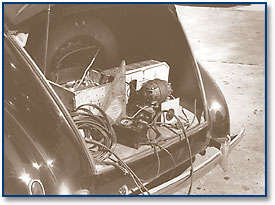
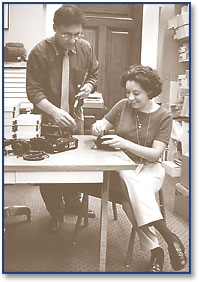
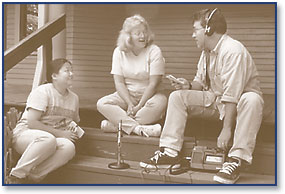
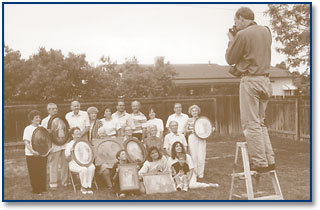
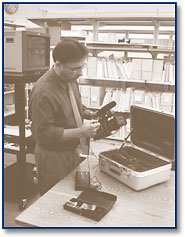
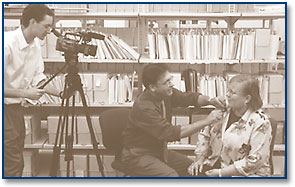
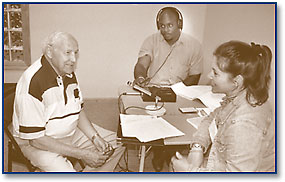
 Generally speaking, a release form is not needed in cases where people are
publically participating in public events -- a photograph of a large group
of people watching a parade or dancing at a festival, for example. But use
caution when photographing or recording professional performers participating
in staged events, since many professional performers do not allow such documentation
without their consent.
Generally speaking, a release form is not needed in cases where people are
publically participating in public events -- a photograph of a large group
of people watching a parade or dancing at a festival, for example. But use
caution when photographing or recording professional performers participating
in staged events, since many professional performers do not allow such documentation
without their consent.